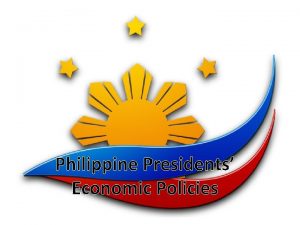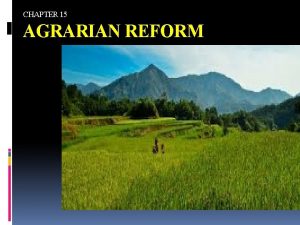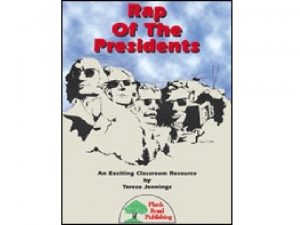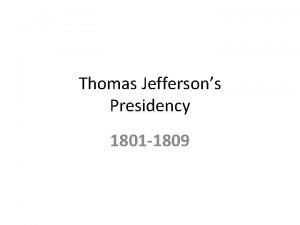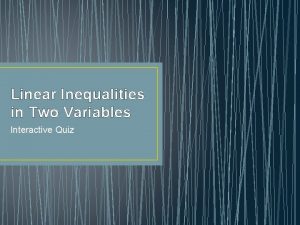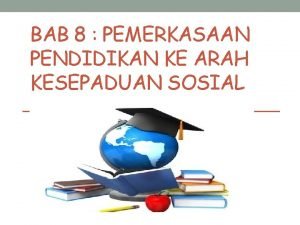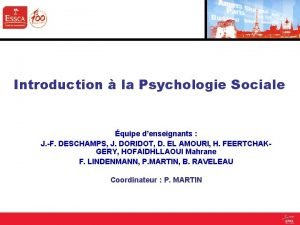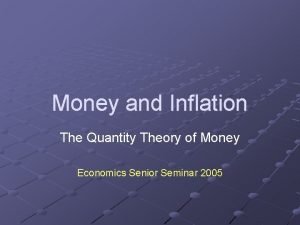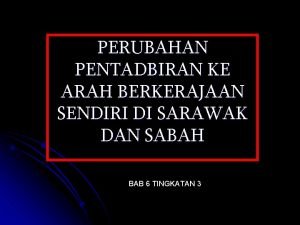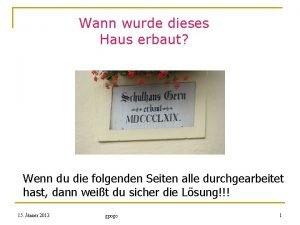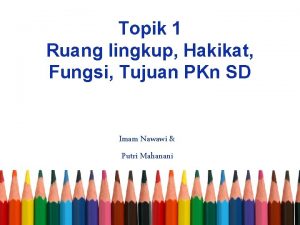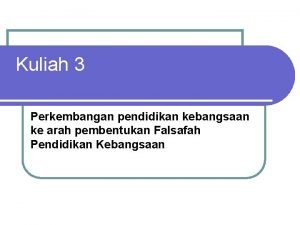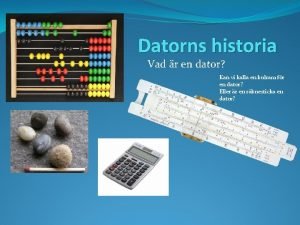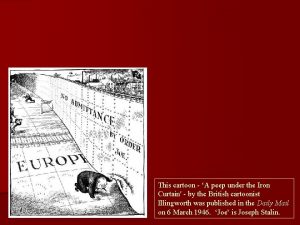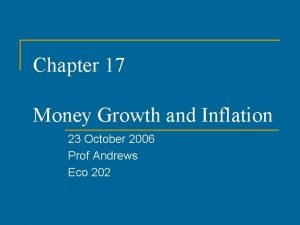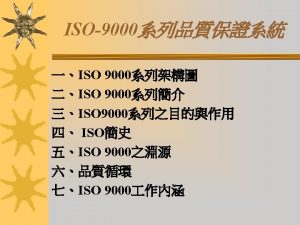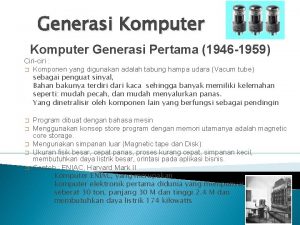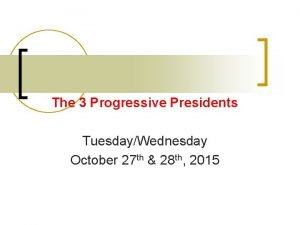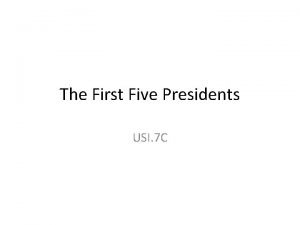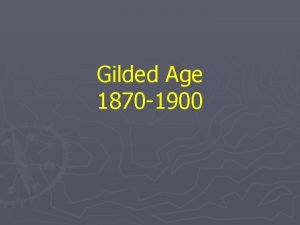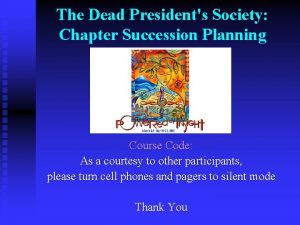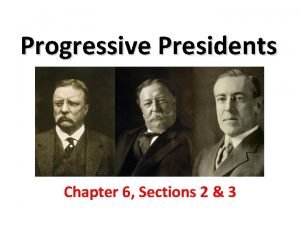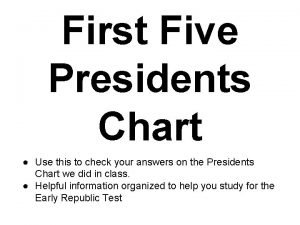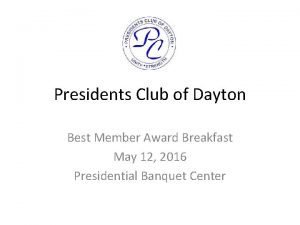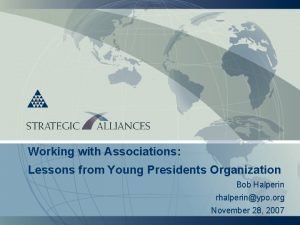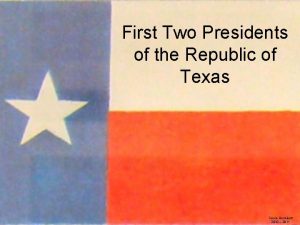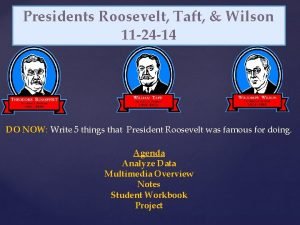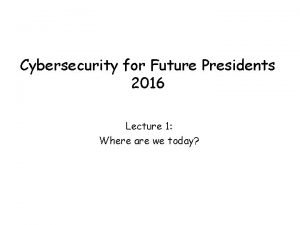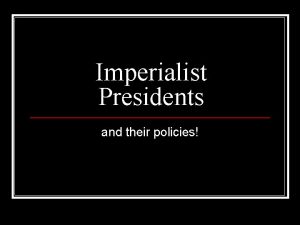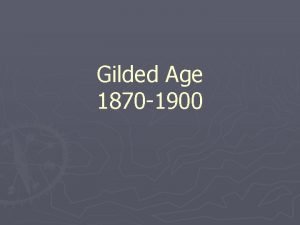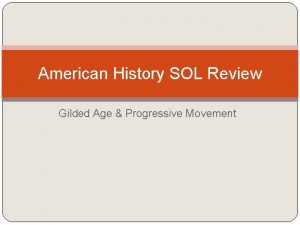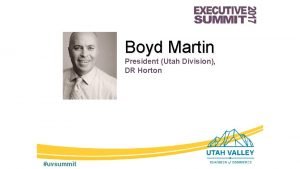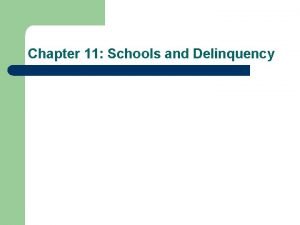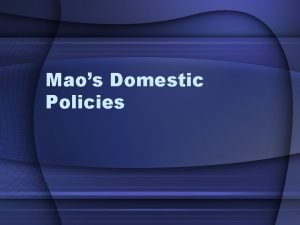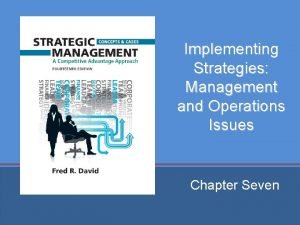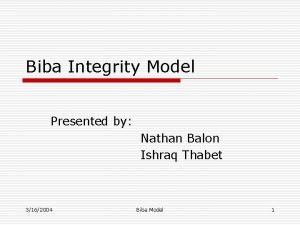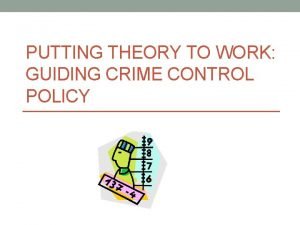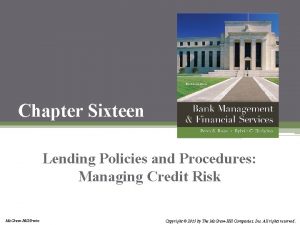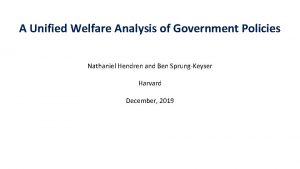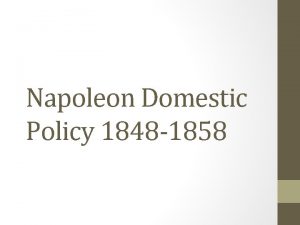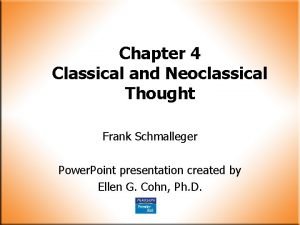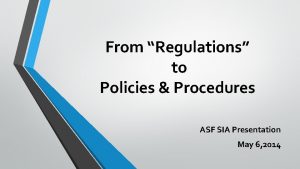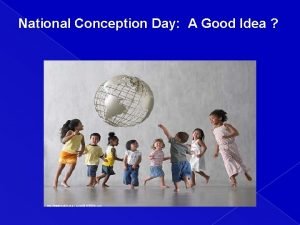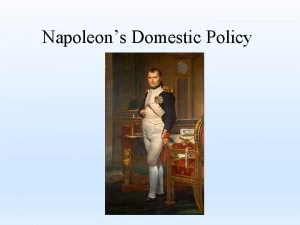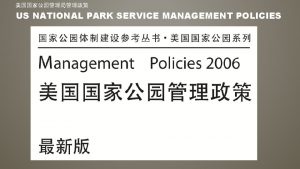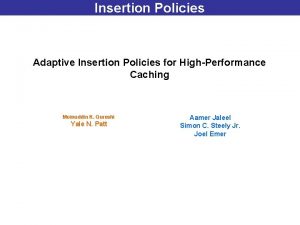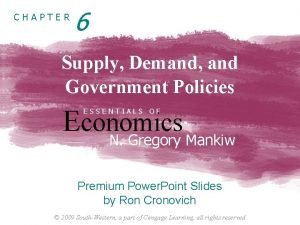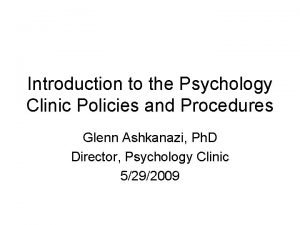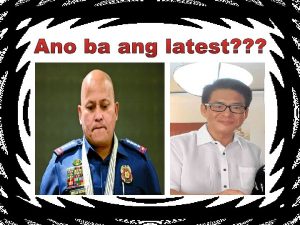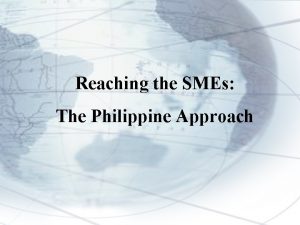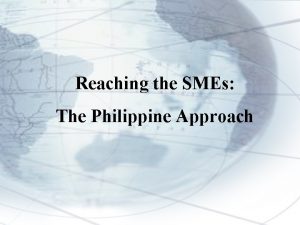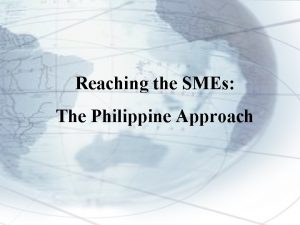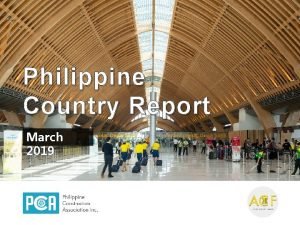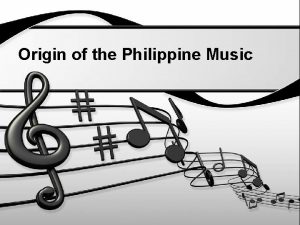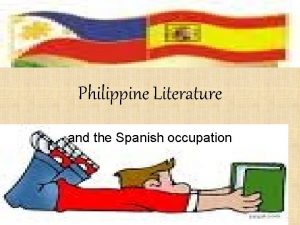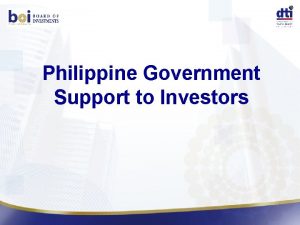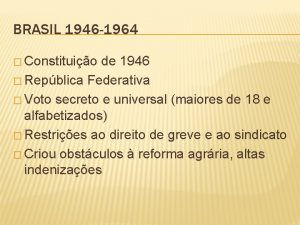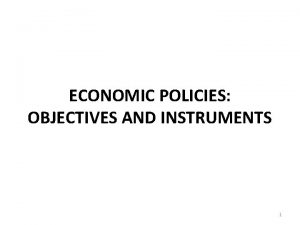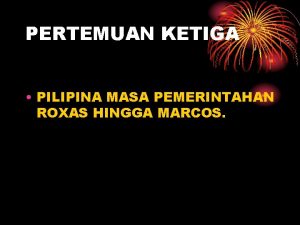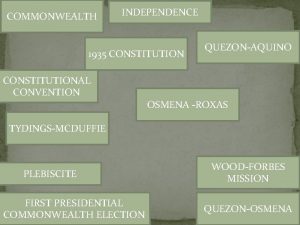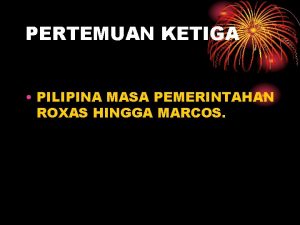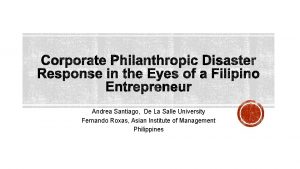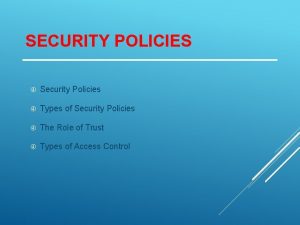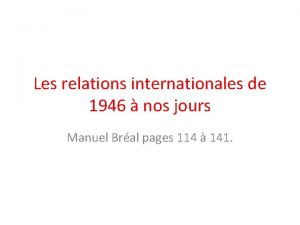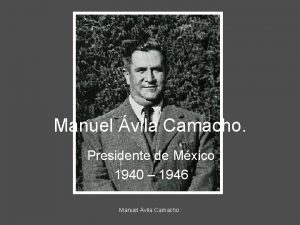Philippine Presidents Economic Policies Manuel A Roxas 1946






































































- Slides: 70

Philippine Presidents’ Economic Policies

Manuel A. Roxas (1946 – 1948) • Rehabilitation and reconstruction in all aspects: – Environmentally, Emotionally, Economically and Culturally. • War Damage Act - liability in respect of damage to, or destruction of, property caused by acts lawfully done during, or in contemplation of the outbreak of, a war in which it is engaged. • Signed US-RP Treaty of General Relations nullifying Philippine independence. This treaty empowered the US government to retain its supreme authority over extensive military bases which it could expand at will, guaranteed the property rights of US corporations and citizens being equal to those of Filipino corporations.

Manuel A. Roxas (1946 – 1948) • US-RP military assistance Pact to control the AFP. • Property Act provided that all real estate and other property acquired by the US government or its agencies before and after July 4, 1946 would be respected. • The Bell Trade Act explicitly required the Pari�ty Amendment in the constitution to enable the US monopolies to plunder at will Philippine natural resources and operate public utilities, prolonged free trade relations between the Philippines and US and placed Philippine tariff and peso currency under US dictation.

Manuel A. Roxas (1946 – 1948) • Roxas served as the President of the Commonwealth of the Philippines in a brief period, from his subsequent election on May 28, 1946 to July 4, 1946, the scheduled date of the proclamation of Philippine Independence. • Roxas prepared the groundwork for the advent of a free and independent Philippines, assisted by the Congress. – On. June 3, 1946, Roxas appeared for the first time before the joint session of the Congress to deliver his first state of the nation address. Among other things, he told the members of the Congress the grave problems and difficulties the Philippines are set to face and reports of his special trip to the United States–the approval for independence.

Manuel A. Roxas (1946 – 1948) • Economy – Among the main remedies proposed was the establishment of the Philippine Rehabilitation Finance Corporation. This entity would be responsible for the construction of twelve thousand houses and for the grant of easy-term loans in the amount of 177, 000 pesos. Another proposal was the creation of the Central Bank of the Philippines to help stabilize the Philippine dollar reserves and coordinate and the nations banking activities gearing them to the economic progress. – Concentrating on the sugar industry, President Roxas would exert such efforts as to succeed in increasing production from 13, 000 tons at the time of the Philippine liberation to an all-high of one million tons.

Manuel A. Roxas (1946 – 1948) • Reconstruction after the war – The postwar Philippines had burned cities and towns, ruined farms and factories, blasted roads and bridges, shattered industries and commerce, and thousands of massacred victims. The war had paralyzed the educational system, where 80% of the school buildings, their equipment, laboratories and furnitures were destroyed. Numberless books, invaluable documents and works of art, irreplaceable historical relics and family heirlooms, hundreds of churches and temples were burned. The reconstruction of the damaged school buildings alone cost more than Php 126, 000.

Manuel A. Roxas (1946 – 1948) • Reconstruction after the war – The new Republic began to function on an annual deficit of over Php 200, 000 with little prospect of a balanced budget for some years to come. Manila and other cities then were infested with criminal gangs which used techniques of American gangsters in some activities– bank holdups, kidnapping and bu rglaries. In rural regions, especially the provinces of Central Luzon and the Southern Tagalog regions, the Hukbalahaps

Manuel A. Roxas (1946 – 1948) • Agrarian reform – In 1946, shortly after his induction to Presidency, Manuel Roxas proclaimed the Rice Share Tenancy Act of 1933 effective throughout the country. However problems of land tenure continued. In fact these became worse in certain areas. Among the remedial measures enacted was Republic Act No. 1946 likewise known as the Tenant Act which provided for a 70– 30 sharing arrangements and regulated share-tenancy contracts. It was passed to resolve the ongoing peasant unrest in Central Luzon.

Manuel A. Roxas (1946 – 1948) • Amnesty proclamation – President Roxas, on January 28, 1948, granted full amnesty to all so-called Philippine collaborators, many of whom were on trial or awaiting to be tried, particularly former President Jose P. Laurel (1943– 1945). The Amnesty Proclamation did not apply to those "collaborators", who were charged with the commission of common crimes, such as murder, rape, and arson. The presidential decision did much to heal a standing wound that somehow threatened to divide the people's sentiments. It was a much-called for measure to bring about a closer unity in the trying times when such was most needed for the progress of the nation.

Manuel A. Roxas (1946 – 1948) • HUKS outlawed – Utterly disgusted with the crimes being committed by HUKBALAHAP or HUKS and in possession of the incontrovertible evidence of the subversive character of the same, President Roxas, on March 6, 1948, in a dramatic gesture, issued a Proclamation outlawing Huks' movement, making it a crime to belong to the same. The declaration was hailed by all responsible and peace-loving elements. The same had become imperative in view of the resurgence of Huk depredations, following the unseating of the seven Communists, led by Huk Supremo Luis Taruc through acts of terrorism.

Manuel A. Roxas (1946 – 1948) • Treaty of General Relations – On August 5, 1946, the Congress of the Philippines ratified the Treaty of General Relations that had been entered into by and between the Republic of the Philippines and the United States on July 4, 1946. Aside from withdrawing her sovereignty from the Philippines and recognizing her independence, the Treaty reserved for the United States some bases for the mutual protection of both countries; consented that the United States represent the Philippines in countries where the latter had not yet established diplomatic representation; made the Philippines assume all debts and obligations of the former government in the Philippines; and provided for the settlement of property rights of the citizens of both countries.

Manuel A. Roxas (1946 – 1948) • United States Military Bases – Although Roxas was successful in getting rehabilitation funds from the United States after independence, he was forced to concede military bases (23 of which were leased for 99 years), trade restriction for the Philippine citizens, and special privileges for U. S. property owner and investor.

Manuel A. Roxas (1946 – 1948) • Parity Rights Amendment – On March 11, 1947, the Filipino people, heeding Roxas' persuasive harangue, ratified in a nationwide plebiscite the "parity amendment" to the 1935 Constitution, granting United States citizens the right to dispose and utilize of Philippine natural resources, or through parity rights. • The night before the plebiscite day, Roxas narrowly escaped an assassination by a disgruntled Tondo barber, Julio Guillen, who hurled a grenade on the platform at Plaza Miranda immediately after the President addressed the rally of citizens.

Elpidio Quirino (1948 – 1953) • Elpidio Quirino's six years as president were marked by notable postwar reconstruction, general economic gains, and increased economic aid from the United States. Basic social problems, however, particularly in the rural areas, remained unsolved, and his administration was tainted by widespread graft and corruption.

Elpidio Quirino (1948 – 1953) • Created the Agricultural Credit Cooperative Financing Administration (ACCFA) - To facilitate the financial help extended to the farmers. • Import controls was improved in 1949 to conserve the dollar reserves. In 1953 an entire system of foreign exchange controls was applied to further put a brake on the depletion of the financial resources of the government.

Elpidio Quirino (1948 – 1953) • US dispatched Bell Mission to make an economic survey and make recommendations to Quirino government. • It paved the way for the imposition of the Economic and Technical assistance agreement of 1951 which required the placement of US advisers in the strategic offices of government to ensure perpetuation of US policy. • Agreement relating to entry of US Traders and investors was signed in 1953 facilitating the entry of US capital and managerial personnel into the Philippines.

• Elpidio Quirino (1948 – 1953) Economy – Upon assuming the reins of government, Quirino announced two main objectives of his administration: first, the economic reconstruction of the nation and second, the restoration of the faith and confidence of the people in the government. • In connection to the first agenda, he created the President's Action Committee on Social Amelioration or PACSA to mitigate the sufferings of indigent families, the Labor Management Advisory Board to advise him on labor matters, the Agricultural Credit Cooperatives Financing Administration or ACCFA to help the farmers market their crops and save them from loan sharks, and the Rural Banks of the Philippines to facilitate credit utilities in rural areas.

Elpidio Quirino (1948 – 1953) • Social Program – Enhancing President Manuel Roxas' policy of social justice to alleviate the lot of the common mass, President Quirino, almost immediately after assuming office, started a series of steps calculated to effectively ameliorate the economic condition of the people. After periodic surprise visits to the slums of Manila and other backward regions of the country, President Quirino officially made public a seven-point program for social security, o wit:

Elpidio Quirino (1948 – 1953) • Social Program • Unemployment insurance • Old-age insurance • Accident and permanent disability insurance • Health insurance • Maternity insurance • State relief • Labor opportunity

Elpidio Quirino (1948 – 1953) • Social Program – President Quirino also created the Social Security Commission, making Social Welfare Commissioner Asuncion Perez chairman of the same. This was followed by the creation of the President's Action Committee on Social Amelioration, charges with extending aid, loans, and relief to the less fortunate citizens. Both the policy and its implementation were hailed by the people as harbingers of great benefits.

Elpidio Quirino (1948 – 1953) • Agrarian Reform – As part of his Agrarian Reform agenda, President Quirino issued on October 23, 1950 Executive Order No. 355 which replaced the National Land Settlement Administration with Land Settlement Development Corporation (LASEDECO) which takes over the responsibilities of the Agricultural Machinery Equipment Corporation and the Rice and Corn Production Administration.

Elpidio Quirino (1948 – 1953) • Integrity Board – To cope with the insistent clamor for government improvement, President Quirino created the Integrity Board to probe into reports of graft and corruption in high government places. Vice. President Fernando Lopez was most instrumental, through his courageous exposes, in securing such a decision from President Quirino.

Elpidio Quirino (1948 – 1953) • Quirino's administration excelled in diplomacy, impressing foreign heads of states and world statesmen by his intelligence and culture. In his official travels to the United States, European countries, and Southeast Asia, he represented the Philippines with flying colors. During his six years of administration, he was able to negotiate treaties and agreements with other nations of the Free World. Two Asian heads of state visited Philippines–President Chiang Kaishek of the Republic of China in July 1949 and President Achmed Sukarno of Indonesia in January 1951.

Elpidio Quirino (1948 – 1953) • In 1950, at the onset of the Korean War, Quirino authorized the deployment of over 7, 450 Filipino soldiers to Korea, under the designation of the Philippine Expeditionary Forces to Korea or PEFTOK.

Elpidio Quirino (1948 – 1953) • Korean War – On June 25, 1950, the world was astonished to hear the North Korean aggression against the independent South Korea. The United Nations immediately took up this challenge to the security of this part of the world. Carlos P. Romulo soon stood out as the most effective spokesman for the South Korean cause. – On behalf of our government, Romulo offered to send a Philippine military contingent to be under the overall command of General Douglas Mac. Arthur, who had been named United Nations Supreme Commander for the punitive expedition. The Philippines, thus, became the first country to join the United States in the offer of military assistance to beleaguered South Korea.

Elpidio Quirino (1948 – 1953) • Korean War – President Quirino took the necessary steps to make the Philippine offer. On a purely voluntary basis, the first contingent – the tenth Combat Battalion Team – was formed under Col. Azurin, and dispatched to Korea, where its members quickly won much renown for their military skill and bravery. The name of Captain Jose Artiaga, Jr. , heroically killed in action, stands out as a symbol of our country's contribution to the cause of freedom outside native shores. Other Philippine Combat Teams successively replaced the first contingent sent, and they all built a name for discipline, tenacity, and courage, until the truce that brought the conflict to a halt.

Elpidio Quirino (1948 – 1953) • Quirino-Foster Agreement – By the time of the creation of the integrity board, moreover, the Bell Mission, led by Daniel W. Bell, an American banker, and composed of five members, with a staff of twenty workers, following their period of stay in the Philippines, beginning in July 1950, finally submitted its report on October of the same year.

Elpidio Quirino (1948 – 1953) • Quirino-Foster Agreement – The Report made several proposals, most noteworthy, of which were that the United States should give the Philippines 250, 000 dollars over a period of five years, but the Philippines, in return, ought to reform its tax structure, enact a minimum wage law for agricultural and industrial labor, initiate social and land reforms, as well as a sound planning for economic development, For all the strong language of the Report, which, in some quarters merited bitter opposition, President Quirino gamely and patriotically, took in the recommendations and sought to implement them. – Thus in November 1950, President Quirino and William Foster, representing the United States Government, signed an agreement by virtue of which the former pledged to obtain the necessary Philippine legislation, in keeping with the Bell Mission Report, while envoy Foster promised the necessary by the same Report.

Elpidio Quirino (1948 – 1953) • However, much as he tried to become a good president, Quirino failed to win the people's affection. Several factors caused the unpopularity of his administration, namely: – Unabated rampage of graft and corruption in his government, as revealed in the Tambobong-Buenavista scandal, the Import Control Anomalies, the Caledonia Pile Mess and the Textbook Racket; – Wasteful spending of the people's money in extravagant junkets abroad; – Failure of government to check the Huk menace which made travel in the provinces unsafe, as evidenced by the killing of former First Lady Aurora Quezon and her companions on April 28, 1949 by the Huks on the Bongabong-Baler road, Baler, Tayabas (now part of Aurora province).

Elpidio Quirino (1948 – 1953) – Economic distress of the times, aggravated by rising unemployment rate, soaring prices of commodities, and unfavorable balance of trade. Quirino's vaunted "Total Economic Mobilization Policy" failed to give economic relief to the suffering nation. – Frauds and terrorism committed by the Liberal Party moguls in the 1947, 1949 and 1951 elections.

Ramon Magsaysay (1954 – 1957 ) • In the Election of 1953, Magsaysay was decisively elected president over the incumbent Elpidio Quirino. He was sworn into office wearing the Barong Tagalog, a first by a Philippine president. He was then called "Mambo Magsaysay". • As president, he was a close friend and supporter of the United States and a vocal spokesman against communism during the Cold War. He led the foundation of the Southeast Asia Treaty Organization also known as the Manila Pact of 1954, that aimed to defeat communist-Marxist movements in South East Asia, South Asia and the Southwestern Pacific.

Ramon Magsaysay (1954 – 1957 ) • • During his term, he made Malacañang literally a "house of the people", opening its gates to the public. – One example of his integrity followed a demonstration flight aboard a new plane belonging to the Philippine Air Force (PAF): President Magsaysay asked what the operating costs per hour were for that type of aircraft, then wrote a personal check to the PAF, covering the cost of his flight. – In history, he is the first Philippine president to wear a barong tagalog in his inauguration. He brought back the people's trust to the military and to the government. His administration was considered one of the cleanest and most corruption-free; his presidency was cited as the Philippines' Golden Years. Trade and industry flourished, the Philippine military was at its prime, and the Filipino people were given international recognition in sports, culture and foreign affairs. The Philippines ranked second in Asia's clean and well-governed countries.

Ramon Magsaysay (1954 – 1957 ) • Known as the “Man of the Masses” • Constructed Bridges, Roads and Irrigation. • Solve the problems on land through Land Reformed Act of 1955. Gave emphasis on the welfare of the poor farmers who desired to own agricultural land. • Established National Resettlement and Rehabilitation act (NARRA) to gave land to some farmers. • Establish (FACOMA) Farmers Cooperative Marketing Association to organized the farmers.

Ramon Magsaysay (1954 – 1957 ) • Signed the 1 st Agricultural Commodities Agreement with the US in 1957. The agreement was designed to make use of US agricultural surplus, keep local agricultural production at the mercy of US, control intermediate industries requiring imported agricultural raw materials. • Laurel-Langley was made allowing the US monopolies to enjoy parity rights in all kinds of businesses. • Adjustments in the quota system and preferential treatment for Philippine raw materials were made Reassembly and packaging plants were put up to create the illusion of local industrialization and import substitution. • The Ohno-Garcia reparations Agreement was made enabling Japan to penetrate the Philippine economy through the system of delivering reparations goods.

Ramon Magsaysay (1954 – 1957 ) • President's Action Body – Ushering, indeed, a new era in Philippine government, President Magsaysay placed emphasis upon service to the people by bringing the government closer to the former. This was symbollically seen when, on inauguration day, President Magsaysay ordered the gates of Malacañang Palace open to all and sundry, who were allowed to freely visit all the dependencies of the presidential mansion. Later, this was regulated to allow weekly visit.

Ramon Magsaysay (1954 – 1957 ) • President's Action Body – True to his electoral promise, President Magsaysay created the Presidential Complaints and Action Committee. This body immediately proceeded to hear grievances and recommend remedial action. • Headed by soft-spoken, but active and tireless, Manuel Manahan, this committee would come to hear nearly sixty thousand complaints in a year, of which more than thirty thousand would be settled by direct action and a little more than twenty five thousand, referred to government agencies for appropriate follow-up. – This new entity, composed of youthful personnel, all loyal to the President, proved to be a highly successful morale booster restoring the people's confidence in their own government.

Ramon Magsaysay (1954 – 1957 ) • Agrarian Reform – President Ramón Magsaysay enacted the following laws as part of his Agrarian Reform Program: • Republic Act No. 1160 of 1954—Abolished the LASEDECO and established the National Resettlement and Rehabilitation Administration (NARRA) to resettle dissidents and landless farmers. It was particularly aimed at rebel returnees providing home lots and farmlands in Palawan and Mindanao. • Republic Act No. 1199 (Agricultural Tenancy Act of 1954) – governed the relationship between landowners and tenant farmers by organizing share-tenancy and leasehold system. The law provided the security of tenure of tenants. It also created the Court of Agrarian Relations.

Ramon Magsaysay (1954 – 1957 ) • Republic Act No. 1400 (Land Reform Act of 1955) – Created the Land Tenure Administration (LTA) which was responsible for the acquisition and distribution of large tenanted rice and corn lands over 200 hectares for individuals and 600 hectares for corporations. • Republic Act No. 821 (Creation of Agricultural Credit Cooperative Financing Administration) – Provided small farmers and share tenants loans with low interest rates of six to eight percent

Ramon Magsaysay (1954 – 1957 ) • HUKBALAHAP – In early 1954, Benigno Aquino, Jr. was appointed by President Ramón Magsaysay to act as personal emissary to Luís Taruc, leader of the Hukbalahap, a rebel group. • Also in 1954, Lt. Col. Laureño Maraña, the former head of Force X of the 16 th PC Company, assumed command of the 7 th BCT, which had become one of the most mobile striking forces of the Philippine ground forces against the Huks, from Colonel Valeriano. Force X employed psychological warfare through combat intelligence and infiltration that relied on secrecy in planning, training, and execution of attack. The lessons learned from Force X and Nenita were combined in the 7 th BCT.

Ramon Magsaysay (1954 – 1957 ) • HUKBALAHAP – With the all out anti-dissidence campaigns against the Huks, they numbered less than 2, 000 by 1954 and without the protection and support of local supporters, active Huk resistance no longer presented a serious threat to Philippine security. From February to mid. September 1954, the largest anti. Huk operation, "Operation Thunder. Lightning" was conducted that resulted to the surrender of Luis Taruc on May 17. Further clean up operations of guerillas remaining lasted throughout 1955, diminishing its number to less than 1, 000 by year's end.

Ramon Magsaysay (1954 – 1957 ) • SEATO – The administration of President Magsaysay was active in the fight against the expansion of communism in the Asian region. He made the Philippines a member of the Southeast Asia Treaty Organization (SEATO), which was established in Manila on Sept. 8, 1954 during the "Manila Conference". • Members of SEATO were alarmed at the possible victory of North Vietnam over South Vietnam, which could spread communist ideology to other countries in the region. The possibility that a communist state can influence or cause other countries to adopt the same system of government is called the domino theory.

Ramon Magsaysay (1954 – 1957 ) • SEATO – The active coordination of the Magsaysay administration with the Japanese government led to the Reparation Agreement. This was an agreement between the two countries, obligating the Japanese government to pay $800 million as reparation for war damages in the Philippines.

Ramon Magsaysay (1954 – 1957 ) • Defense Council – Taking the advantage of the presence of U. S. Secretary John Foster Dulles in Manila to attend the SEATO Conference, the Philippine government took steps to broach with him the establishment of a Joint Defense Council. Vice-President and Secretary of Foreign Affairs Carlos P. Garcia held the opportune conversations with Secretary Dulles for this purpose. Agreement was reached thereon and the first meeting of the Joint United States. Philippines Defense Council was held in Manila following the end of the Manila Conference. Thus were the terms of the Mutual Defense Pact between the Philippines and the United States duly implemented.

Ramon Magsaysay (1954 – 1957 ) • Laurel- Langey Agreement – The Magsaysay administration negotiated the Laurel-Langley Agreement which was a trade agreement between the Philippines and the United States which was signed in 1955 and expired in 1974. Although it proved deficient, the final agreement satisfied nearly all of the diverse Filipino economic interests. – While some have seen the Laurel-Langley agreement as a continuation of the 1946 trade act, Jose P. Laurel and other Philippine leaders recognized that the agreement substantially gave the country greater freedom to industrialize while continuing to receive privileged access to US markets. • The agreement replaced the unpopular Bell Trade Act, which tied the economy of the Philippines to that of United States economy.

Ramon Magsaysay (1954 – 1957 ) • Reparations agreement – Following the reservations made by Ambassador Romulo, on the Philippines behalf, upon signing the Japanese Peace Treaty in San Francisco on September 8, 1951, for several years of series of negotiations were conducted by the Philippine government and that of Japan. In the face of adamant claims of the Japanese government that it found impossible to meet the demand for the payment of eight billion dollars by the way of reparations, president Magsaysay, during a so-called "cooling off" period, sent a Philippine Reparations Survey Committee, headed by Finance Secretary Jaime Hernandez, to Japan for an "on the spot" study of that country's possibilities.

Ramon Magsaysay (1954 – 1957 ) • Reparations agreement – When the Committee reported that Japan was in a position to pay, Ambassador Felino Neri, appointed chief negotiator, went to Tokyo. On May 31, 1955, Ambassador Neri reached a compromise agreement with Japanese Minister Takazaki, the main terms of which consisted in the following: The Japanese government would pay eight hundred million dollars as reparations. Payment was to be made in this wise: Twenty million dollars would be paid in cash in Philippine currency; thirty million dollars, in services; five million dollars, in capital goods; and two hundred and fifty million dollars, in long-term industrial loans.

Ramon Magsaysay (1954 – 1957 ) • Reparations agreement – On August 12, 1955, President Magsaysay informed the Japanese government, through Prime Minister Ichiro Hatoyama, that the Philippines accepted the Neri-Takazaki agreement. In view of political developments in Japan, the Japanese Prime Minister could only inform the Philippine government of the Japanese acceptance of said agreement on March 15, 1956. The official Reparations agreement between the two government was finally signed at Malacañan Palace on May 9, 1956, thus bringing to a rather satisfactory conclusion this long drawn controversy between the two countries.

Carlos P. Garcia ( 1957 – 1961 ) • At the time of the sudden death of President Ramon Magsaysay, Vice President and Foreign Affairs Secretary Carlos P. García was heading the Philippine delegation to the SEATO conference then being held at Canberra, Australia. Having been immediately notified of the tragedy, Vice President García enplaned back for Manila. Upon his arrival he directly repaired to Malacañan Palace to assume the duties of President. Chief Justice Ricardo Paras, of the Supreme Court, was at hand to administer the oath of office. President García's first actuations dealt with the declaration of a period of mourning for the whole nation and the burial ceremonies for the late Chief-Executive Magsaysay.

Carlos P. Garcia ( 1957 – 1961 ) • Filipino First Policy was made as an apparent concession to a growing anti -imperialist among the people. • Giving preference to Filipino businessmen in the allocation of US dollars for import-export operations over foreign businessmen of a nationality other than American. • Objective is to free our economy from foreign intervention and control. • Gave priority to Filipino industries in the distribution of resources which supported the Retail Nationalization Act. • Gives recognition to the outstanding contribution of Filipino artists, scientists, musicians, historians and inventors.

Carlos P. Garcia ( 1957 – 1961 ) • Remove foreign exchange controls • Foreign exchange controls is a temporary device for putting a brake to the rapid depletion of US dollars for helping prevent the complete breakdown of economy. • US wanted a more favorable climate foreign investments in the Philippines and the unlimited remittance of its superprofits. • US wanted an intensified export of its surplus products to Philippines to counteract its uneven balance of payments problems. • US used the WB_IMF to make an economic survey and recommend the adoption of immediate and full decontrol as the cornerstone of development.

Carlos P. Garcia ( 1957 – 1961 ) • Outlawing Communism – After much discussion, both official and public, the Congress of the Philippines, finally, approved a bill outlawing the Communist Party of the Philippines. Despite the pressure exerted against the congressional measure, President Carlos P. García signed the said bill into law as Republic Act No. 1700 on June 19, 1957. With this legislative piece, the sustained government campaign for peace and order achieved considerable progress and success. • Republic Act No. 1700 was superseded by Presidential Decree No. 885, entitled "Outlawing Subversive Organization, Penalizing Membership Therein and For Other Purposes. " In turn, Presidential Decree 885 was amended by Presidential Decree No. 1736, and later superseded by Presidential Decree No. 1835, entitled, "Codifying The Various Laws on Anti-Subversion and Increasing the Penalties for Membership in Subversive Organization. " This, in turn, was amended by Presidential Decree No. 1975. On May 5, 1987, Executive Order No. 167 repealed Presidential Decrees Nos. 1835 and 1975 as being unduly restrictive of the constitutional right to form associations. • On September 22, 1992, Republic Act No. 1700, as amended, was repealed by Republic Act No. 7636.

• Carlos P. Garcia ( 1957 – 1961 ) Filipino First Policy – President García exercised the Filipino First Policy, for which he was known. This policy heavily favored Filipino businessmen over foreign investors. He was also responsible for changes in retail trade which greatly affected the Chinese businessmen in the country. In a speech during a joint session of the Senate and the House of Representatives on September 18, 1946, President Garcia said the following: • We are called upon to decide on this momentous debate whether or not this land of ours will remain the cradle and grave, the womb and tomb of our race – the only place where we can build our homes, our temples, and our altars and where we erect the castles of our racial hopes, dreams and traditions and where we establish the warehouse of our happiness and prosperity, of our joys and sorrows

Carlos P. Garcia ( 1957 – 1961 ) • Austerity Program – In the face of the trying conditions of the country, President García initiated what has been called "The Austerity Program". García's administration was characterized by its austerity program and its insistence on a comprehensive nationalist policy. On March 3, 1960, he affirmed the need for complete economic freedom and added that the government no longer would tolerate the dominance of foreign interests (especially American) in the national economy. He promised to shake off "the yoke of alien domination in business, trade, commerce and industry. " García was also credited with his role in reviving Filipino cultural arts.

Carlos P. Garcia ( 1957 – 1961 ) • • Austerity Program – The main points of the Austerity Program were: • The government would tighten up its controls to prevent abuses in the over shipment of exports under license and in under-pricing as well. • There would be a more rigid enforcement of the existing regulations on barter shipments. • Government imports themselves were to be restricted to essential items. • The government also would reduce rice imports to a minimum. • An overhauling of the local transportation system would be attempted so as to reduce the importation of gasoline and spare parts. • The tax system would be revised so as to attain more equitable distribution of the payment-burden and achieve more effective collection from those with ability to pay. • There would be an intensification of food production. The program was hailed by the people at large and confidence was expressed that the measures proposed would help solve the standing problems of the Republic.

Carlos P. Garcia ( 1957 – 1961 ) • Bohlen–Serrano Agreement – During his administration, he acted on the Bohlen– Serrano Agreement which shortened the lease of the US Bases from 99 years to 25 years and made it renewable after every five years.

Diosdado Macapagal ( 1961 – 1965 ) • In the 1961 presidential election, Macapagal ran against Garcia's re-election bid, promising an end to corruption and appealing to the electorate as a common man from humble beginnings. – He defeated the incumbent president with a 55% to 45% margin. His inauguration as the president of the Philippines took place on December 30, 1961.

Diosdado Macapagal ( 1961 – 1965 ) • Lifted the control on foreign currencies and allowed the importation of goods which resulted to devaluation. • Local US firms were enabled to remit huge profits even without having to conceal them any more through overpricing of goods and services both from their mother and sister companies in the US or elsewhere abroad. • Signed the Agricultural Land Reform Code which abolished the Kasama System tilling the land.

Diosdado Macapagal ( 1961 – 1965 ) • Established the Land Bank of the Philippines. • Dollar reserves were exhausted. Peso was devalued from the previous fixed rate of P 2. 00 to P 3. 90 per dollar. To maintain this rate, the Macapagal government accepted the onerous ‘stabilization’ loans from US banks. • Advocated an open door policy for US investments. • The volume of US investments increased but not any higher than the huge profits being remitted.

Diosdado Macapagal ( 1961 – 1965 ) • US investors took over enterprises which could no longer pay their foreign debts and made new investments in plantations. • US monopolies suck up Filipino savings and loan capital taken by the Philippine Government from US-owned and controlled banks. • Thus even with the very little capital that they usually brought into the country. They could enlarge their capitalization through local borrowings. • Government corporations were made to borrow directly from the WB. Private corporations and banks were encouraged to get loans directly from US and other foreign banks and to use government banks to make guarantees.

Diosdado Macapagal ( 1961 – 1965 ) • Economy – In his inaugural address, Macapagal promised a socio-economic program anchored on "a return to free and private enterprise", placing economic development in the hands of private entrepreneurs with minimal government interference. – Twenty days after the inauguration, exchange controls were lifted and the Philippine peso was allowed to float on the free currency exchange market. The currency controls were initially adopted by the administration of Elpidio Quirino as a temporary measure, but continued to be adopted by succeeding administrations. The peso devalued from P 2. 64 to the US dollar, and stabilized at P 3. 80 to the dollar, supported by a $300 million stabilization fund from the International Monetary Fund.

Diosdado Macapagal ( 1961 – 1965 ) • Socio-economic program – The removal of controls and the restoration of free enterprise was intended to provide only the fundamental setting in which Macapagal could work out economic and social progress. A specific and periodic program for the guidance of both the private sector and the government was an essential instrument to attain the economic and social development that constituted the goal of his labors.

Diosdado Macapagal ( 1961 – 1965 ) • Socio-economic program – Such a program for his administration was formulated under his authority and direction by a group of able and reputable economic and business leaders the most active and effective of which was Sixto Roxas III. From an examination of the planned targets and requirements of the Five-Year program – formally known as the Five-Year Socio. Economic Integrated Development Program – it could be seen that it aimed at the following objectives. • immediate restoration of economic stability; • alleviating the plight of the common man; and • establishing a dynamic basic for future growth.

Diosdado Macapagal ( 1961 – 1965 ) • Land reform – Like Ramon Magsaysay, President Diosdado Macapagal came from the masses. He savored to call himself the "Poor boy from Lubao". • Ironically, he had little popularity among the masses. This could be attributed to an absence of charismatic appeal of his stiff personality. – But despite this, Macapagal had certain achievements. Foremost of these was the Agricultural Land Reform Code of 1963 (Republic Act No. 3844) which provided for the purchase of private farmlands with the intention of distributing them in small lots to the landless tenants on easy term of payment.

Diosdado Macapagal ( 1961 – 1965 ) • Anti-corruption drive – One of Macapagal's major campaign pledges had been to clean out the government corruption that had proliferated under former President Garcia. – The administration also openly feuded with Filipino businessmen Fernando Lopez and Eugenio Lopez, brothers who had controlling interests in several large businesses. – The administration alluded to the brothers as "Filipino Stonehills who build and maintain business empires through political power, including the corruption of politicians and other officials". [13] In the 1965 election, the Lopezes threw their support behind Macapagal's rival, Ferdinand Marcos, with Fernando as Marcos' running mate.

Diosdado Macapagal ( 1961 – 1965 ) • Independence Day – Macapagal appealed to nationalist sentiments by shifting the commemoration of Philippine independence day. – On May 12, 1962, he signed a proclamation which declared Tuesday, June 12, 1962, as a special public holiday in commemoration of the declaration of independence from Spain on that date in 1898. – The change became permanent in 1964 with the signing of Republic Act No. 4166. For having issued his 1962 proclamation, Macapagal is generally credited with having moved the celebration date of the Independence Day holiday. • Years later, Macapagal told journalist Stanley Karnow the real reason for the change: "When I was in the diplomatic corps, I noticed that nobody came to our receptions on the Fourth of July, but went to the American Embassy instead. So, to compete, I decided we needed a different holiday.

• Diosdado Macapagal ( 1961 – 1965 ) Sabah Claim – On September 12, 1962, during President Diosdado Macapagal's administration, the territory of North Borneo, and the full sovereignty, title and dominion over the territory were ceded by then reigning Sultan of Sulu, HM Sultan Muhammad Esmail E. Kiram I, to the Republic of the Philippines. – The cession effectively gave the Philippine government the full authority to pursue their claim in international courts. – The Philippines broke diplomatic relations with Malaysia after the federation had included Sabah in 1963. – It was revoked in 1989 because succeeding Philippine administrations have placed the claim in the back burner in the interest of pursuing cordial economic and security relations with Kuala Lumpur. – To date, Malaysia continues to consistently reject Philippine calls to resolve the matter of Sabah's jurisdiction to the International Court of Justice. Sabah sees the claim made by the Philippines' Moro leader Nur Misuari to take Sabah to International Court of Justice (ICJ) as a non-issue and thus dismissed the claim.

Diosdado Macapagal ( 1961 – 1965 ) • Maphilindo – Maphilindo was described as a regional association that would approach issues of common concern in the spirit of consensus. However, it was also perceived as a tactic on the parts of Jakarta and Manila to delay, or even prevent, the formation of the Federation of Malaysia. Manila had its own claim to Sabah (formerly British North Borneo), and Jakarta protested the formation of Malaysia as a British imperialist plot. – The plan failed when Sukarno adopted his plan of konfrontasi with Malaysia. The Konfrontasi, or Confrontation basically aims at preventing Malaysia to attain independence. The idea was inspired onto President Sukarno by the Partai Komunis Indonesia (PKI), or literally the Indonesian Communist Party. The party convinced President Sukarno that the Formation of Malaysia is a form of neo-colonization and will later affect tranquility in Indonesia. The subsequent development of ASEAN almost certainly excludes any possibility of the project ever being revived.

Diosdado Macapagal ( 1961 – 1965 ) • Vietnam War – Before the end of his term in 1965, President Diosdado Macapagal persuaded Congress to send troops to South Vietnam. However this proposal was blocked by the opposition led by Senate President Ferdinand Marcos who deserted Macapagal's Liberal Party and defected to the Nacionalista Party.

Ferdinand E. Marcos ( 1965 – 1986 ) • Implemented a number of economic programs that helps the country to enjoy the period of economic growth from the mid 1970’s until the early 1980’s. • Land reform was introduced under PD Nos. 2 and 27. • Kilusang Kabuhayan at Kaunlaran (KKK) – aimed to promote economic development of the Barangay’s by encouraging Barangay residents to engage in their own livelihood projects. • Enacted the investment incentives law on 1967 which declares it the state policy to encourage foreign investments and defines a corporation with a maximum foreign equity of 40% as a Philippine national. • IMF dictated the devaluation of peso.

Ferdinand E. Marcos ( 1965 – 1986 ) • In 1970 P 1. 00 $6. 00 from previous P 3. 90 per US dollars. • P 6 Billion interval debts because of profligate (recklessly wasting) spending on project that merely deepen the semifeudal and semi-colonial character of Phileconomy. • Philippine external debt has reached to $ 1. 9 billion. • Japan-RP Treaty of Amnesty, commerce and navigation has encouraged Japanese monopolies to invade the Philippines. They rank as the 2 nd biggest foreign investors. • Japanese products/commodities were dumped into the country and Japanese investments penetrated every major field of business activity.
 Manuel roxas economic adviser
Manuel roxas economic adviser Compras y vandalas system
Compras y vandalas system These are the presidents the mighty mighty presidents
These are the presidents the mighty mighty presidents What were president jeffersons economic policies
What were president jeffersons economic policies Mrs.roxas gave the cashier
Mrs.roxas gave the cashier Inti pati utama dasar cheeseman 1946
Inti pati utama dasar cheeseman 1946 Expérience de asch 1946
Expérience de asch 1946 Tolman ritchie and kalish (1946)
Tolman ritchie and kalish (1946) Hungary inflation rate 1946
Hungary inflation rate 1946 1980-1946
1980-1946 Maksud berkerajaan sendiri
Maksud berkerajaan sendiri 1946 born
1946 born 1946 römische zahlen
1946 römische zahlen Doctrina brejnev
Doctrina brejnev Ruang lingkup pkn di sd
Ruang lingkup pkn di sd Lbb 1946/00
Lbb 1946/00 Ordinan pelajaran koloni 1956
Ordinan pelajaran koloni 1956 Differensmaskinen
Differensmaskinen Iron curtain cartoon meaning
Iron curtain cartoon meaning Hungary inflation rate 1946
Hungary inflation rate 1946 Iso 1946
Iso 1946 Nueva resurrección david alfaro siqueiros
Nueva resurrección david alfaro siqueiros Komponen komputer generasi keempat
Komponen komputer generasi keempat Carta da paz social 1946
Carta da paz social 1946 Economic growth vs economic development
Economic growth vs economic development Difference between economic growth and economic development
Difference between economic growth and economic development Lesson 2 our economic choices
Lesson 2 our economic choices Who were the 3 progressive presidents
Who were the 3 progressive presidents First five presidents graphic organizer answers
First five presidents graphic organizer answers Presidents team herbalife
Presidents team herbalife What do vice presidents do in clubs
What do vice presidents do in clubs Herbalife umsatz
Herbalife umsatz Gilded age presidents
Gilded age presidents Dead presidents society
Dead presidents society William howard
William howard 1st five presidents chart
1st five presidents chart Presidents club of dayton
Presidents club of dayton Young presidents association
Young presidents association Presidents of the republic of texas
Presidents of the republic of texas Roosevelt taft and wilson venn diagram
Roosevelt taft and wilson venn diagram Wilson gorman tariff apush
Wilson gorman tariff apush Xkcd presidents
Xkcd presidents Isagenix pay structure
Isagenix pay structure President's informal powers
President's informal powers Theodore roosevelt imperialist policies
Theodore roosevelt imperialist policies Gilded age
Gilded age A belief shared by presidents theodore
A belief shared by presidents theodore Drhorton utah
Drhorton utah Conclusion of rmsa
Conclusion of rmsa Crime control policies
Crime control policies Chapter 11 school policies and their functions
Chapter 11 school policies and their functions Maos domestic policies
Maos domestic policies The stamus company's hierarchy of aims
The stamus company's hierarchy of aims Biba n 467 ddl
Biba n 467 ddl Crime control policies
Crime control policies Lending policies and procedures managing credit risk
Lending policies and procedures managing credit risk A unified welfare analysis of government policies
A unified welfare analysis of government policies Domestic policies of napoleon
Domestic policies of napoleon Factors influencing pricing
Factors influencing pricing Classroom policies and procedures
Classroom policies and procedures Crime control policies
Crime control policies Mobile device mailbox policy office 365
Mobile device mailbox policy office 365 Eisenhower domestic policies
Eisenhower domestic policies Policies and procedures presentation
Policies and procedures presentation Family planning advertisement
Family planning advertisement Napoleon's domestic policies
Napoleon's domestic policies Nps management policies
Nps management policies Adaptive insertion policies for high performance caching
Adaptive insertion policies for high performance caching Chapter 6 supply demand and government policies
Chapter 6 supply demand and government policies Expansionary monetary policy aggregate demand
Expansionary monetary policy aggregate demand Ideal clinic policies
Ideal clinic policies
